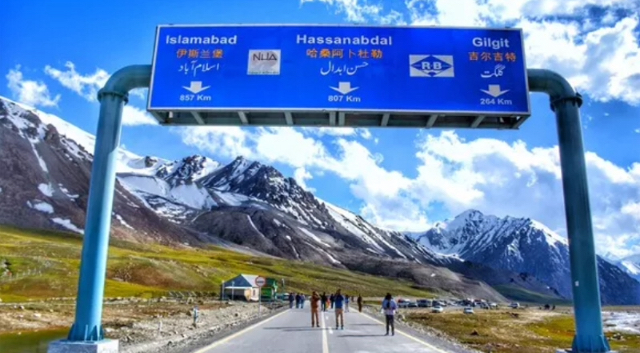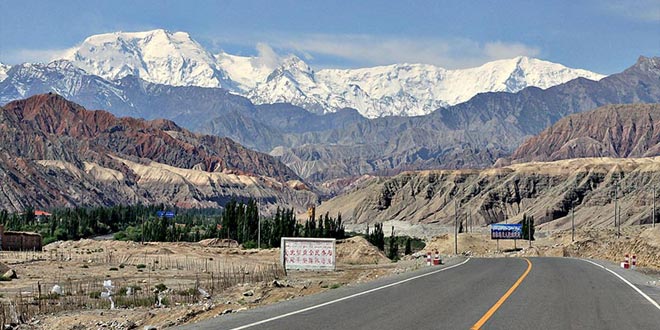Summary: While BRI’s strategic implications for India in its entirety require in-depth analysis, some of the economic corridors proposed by China are prima facie inimical to Indian strategic interests. Of most pressing concern is the China-Pakistan Economic Corridor (CPEC) which passes through Pakistan Occupied Kashmir or PoK which makes its construction a clear case of breach of Indian sovereignty.
The BRI quagmire challenges both the foreign policy of India and also its resolve to stand on its own despite pressures at home and abroad. The way ahead for India is to shed the romanticism of the past in its foreign policy and adapt a pragmatic and forthright intervention on matters that question its interests.
Indian interventions in Maldives debt-crisis and Sri Lanka’s Mattala airport show that it is well aware of these developments. Further, the current competition between USA and China provides India the opportunity to lead the world away from conflict, much like it did in the Cold War. While China has chosen the path of expansionism sugar-coated with terminology of ‘win-win cooperation’, perhaps India can chart new roads.
Indo-China relations are complex to say the least. Historically, trade took place through the Silk Road but interactions were largely limited by the mighty Himalayan barrier. Both share a close cultural link as Indian philosophy, especially Buddhist philosophy, reached China through travelers and scholars like Fa Hien and became an inseparable part of Chinese identity. However, colonization prepared the ground for the strain in their relations at present.
The predicament of India-China relation.
First, the foremost contention is the border issue. The disputed territories are- Aksai Chin and Despang plains in Ladakh, claimed by India on the basis of the Johnson Line decided by the British in 1860s; Trans-Karakoram tract ceded by Pakistan to China in 1963 but still subject to settlement of the dispute between India and Pakistan; Tawang tract in Arunachal Pradesh. The root of the problem lies in the fact that China has a civilizational approach to territory which contradicts with the Westphalian model of state imposed by European colonizers which lent rigidity to previously fluid boundaries.
Second, China enthusiastically brewed its relations with Pakistan keeping India in mind as the common enemy. Chinese aid to Pakistan’s nuclear program is common knowledge. Pakistan ceded large parts of PoK to China in 1963, through which the CPEC passes today. China sided with Pakistan in 1965, and in 1971 denounced Indian intervention in East Pakistan.
Third, both the countries lay overlapping claims of being destined to lead Asia, and usher in the Asian Century. Nehru’s ‘tryst with destiny’ and Mao’s ‘China has stood up’ in tandem with their respective feelings of hurt nationalism at the cruel hands of European colonizers fanned the desire for a central position in global affairs.
Fourth, China aspires to overtake USA as the superpower which makes it binding on Beijing to prove its hegemony in Asia. China’s ambition makes it a compulsion for it to prove superiority over India which is its only viable rival in Asia. In fact, its 1962 victory followed by unilateral withdrawal was geared to establish this.
The strategic economic corridors

While BRI’s strategic implications for India in its entirety require in-depth analysis, some of the economic corridors proposed (and well under implementation) by China are prima facie inimical to Indian strategic interests. Of most pressing concern is the China-Pakistan Economic Corridor (CPEC) which passes through Pakistan Occupied Kashmir or PoK which makes its construction a clear case of breach of Indian sovereignty. CPEC ends at the Gwadar port thus providing China unhindered access to India’s western oceanic flank.
With the annexation of Tibet China shares India’s Himalayan border and the Trans Himalayan Economic Corridor (THEC) provides easier and faster access across the undulating terrain, facilitating swifter movement to and from mainland China to India through its inroads in Nepal. The porosity of the Indo-Nepal border should be kept in mind here.
The Bangladesh-China-India-Myanmar Economic Corridor (BCIMEC) was under consideration amongst the participating countries since the 1990s with the view of stimulating trade to accelerate growth in these counties. China subsumed it as part of BRI in 2013 as a major economic corridor. However, in an interesting turn of events, in the 2nd Belt and Road Forum held in April 2019 (which India boycotted over its CPEC concern) the BCIMEC was missing from the list of corridors mentioned under BRI. While subsequent official statements from China denied dropping it from BRI, this omission is being interpreted as China’s attempts to revive the project stalled due to India’s inhibitions, and also to bring India on board the BRI.
Maritime Silk Road in the Indian Ocean
China considers MSR as central for the success of BRI. By compulsions of geography, China has no considerable foot-print in the Indian Ocean although it does have an electronic intelligence station at the strategically located Coco Island. However, a considerable amount of China’s trade, especially in energy resources, passes through Indian Ocean via the Strait of Malacca, and lack of greater access to it makes the Chinese uneasy. The MSR essentially works towards enhancing China’s presence in the Indian Ocean Region to ensure unhindered supply of energy resources.
As integral to MSR, China seeks to build (acquire) ports at various locations such as Yangon (Myanmar), Palawan (Philippines), Klang (Malaysia), Leam Chabang (Thailand), etc. The plan itself includes Indian port cities as Kolkata, Mundra, and Pipavav etc. It has already secured the Doraleh port in the Arabian Sea through its debt trap diplomacy in Djibouti. Sri Lanka’s Hambantota was acquired in similar fashion. Since India considers it as its own area of influence, China’s power projection here rightly ruffles New Delhi. The creation and militarization of artificial islands in South China Sea should raise concerns in India because nearly 1/3 of India’s trade (by value) is through these waters. Gwadar demonstrates Chinese intentions in Indian Ocean. The tug of war between China and USA will play out in the Indo-Pacific, and there is no way India can avoid it.
The Way Forward for India

Indian interventions in Maldives debt-crisis and Sri Lanka’s Mattala airport show that it is well aware of these developments. Yet, Delhi has been slow in initiating, and implementing a comprehensive and coherent approach to the entire project and China’s expansion. The fundamental cause for this lackluster response is the reactionary nature of India’s foreign policy. There is a lack of comprehensive, long term vision of India’s position in the world order and how that position will be reached. Consequently, the government responds to outer stimulus, instead of taking pro-active steps, most of the times. Even the immediate neighborhood remains relatively ignored until some pressing concern emerges. Relations with strategically vital countries like Maldives, Nepal, and Sri Lanka should have been nurtured to make them our closest allies. In contrast, the Chinese have a clear vision of where and how they see themselves in the long run, and thus back it up with action.
There are those who argue that joining the BRI can yield economic benefits, but politics and economics are inseparable. China’s insensitive and unyielding attitude towards genuine Indian concerns must be kept in mind. It is of utmost importance for China to prove its supremacy in Asia which naturally means there is no space for sharing. Guided by its experience of ‘Hindi Chini Bhai Bhai’ India is wary of taking the Chinese for their word when they claim that BRI is for peace, cooperation and partnership.
India can shape its future responses at two possible levels- first, provide better alternative to BRI. According to the Asian Development Bank, developing Asia will need to invest $1.7 trillion per year in infrastructure until 2030 to maintain its growth momentum, tackle poverty, and respond to climate change. Developing and underdeveloped countries such as Kazakhstan, Djibouti, Maldives, Nepal etc are lacking in infrastructure and also in the means to create it. Joining the BRI seemingly provides them a solution along with better prospects for trade and employment (the extent of it is under scanner now). Realistically speaking, India lacks the economic means to do so. It needs to partner with other like-minded players who are not comfortable with the Chinese expansion like USA, Japan, and others. There are distant plans of offering alternatives to the initiative like the Asia-Africa Growth Corridor or the North South Transit Corridor through partnerships with other countries, but efforts to materialize them are lethargic.
Second, develop an alternative framework for development and world politics. This is what China is trying but unable to do. There is no fundamental difference between the Chinese and western liberal view of progress, the international order and its basic principles. India’s own development trajectory is based on the same modernist principles. The discourse in New Delhi revolves around building India into a superpower, remain the most dominant player in Asia, expand the economy through more and more industrialization and so forth. Each passing day argues against the feasibility of such notions.
The current competition between the USA and China provides India the opportunity to lead the world away from conflict, much like it did in the Cold War. One of India’s foremost contributions to international relations, the NAM was born out of compulsions of the Cold War between the USA and USSR.
Modernist notion of linear development along industrial lines, coupled with realist principles of international system has proven to be unsustainable and incapable of delivering peace and happiness. A Eurocentric bias precludes different meanings that can be attributed to ideas like sovereignty, state, progress etc. For instance Arvind Ghosh’s idea of nationalism is unattended in international relations because of its ‘unrealistic’ spiritual connotations. The NAM is not given its due importance because it does not suit the realist paradigm.
The ideological drivers of the current international system have proven themselves incapable of providing peace, security and stability to the world. This is a niche that India can fill by drawing upon its unique philosophical traditions, to provide genuine alternative conception of growth, development, and international relations. Humanity needs sustainable guiding principles. While China has chosen the path of expansionism sugar-coated with terminology of ‘win-win cooperation’, perhaps India can chart new roads.
(The author is a political science research scholar. This is the concluding piece in the series on BRI.)
Political Science research scholar
